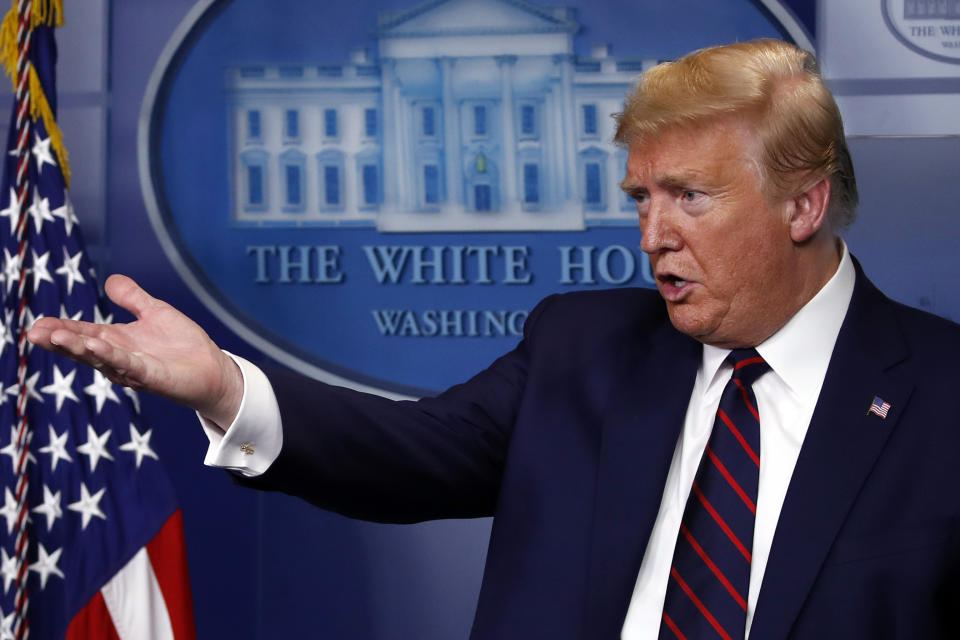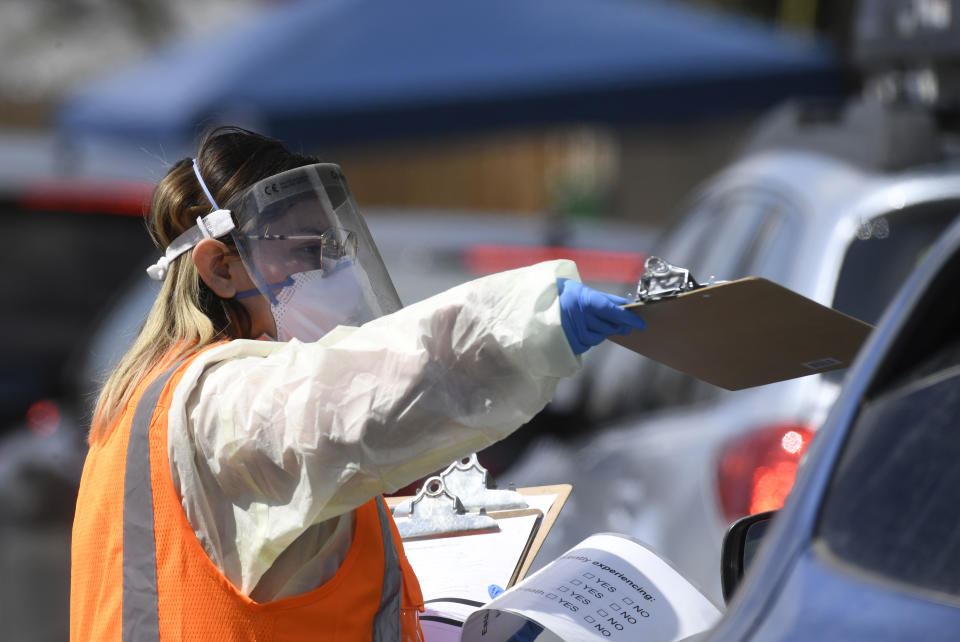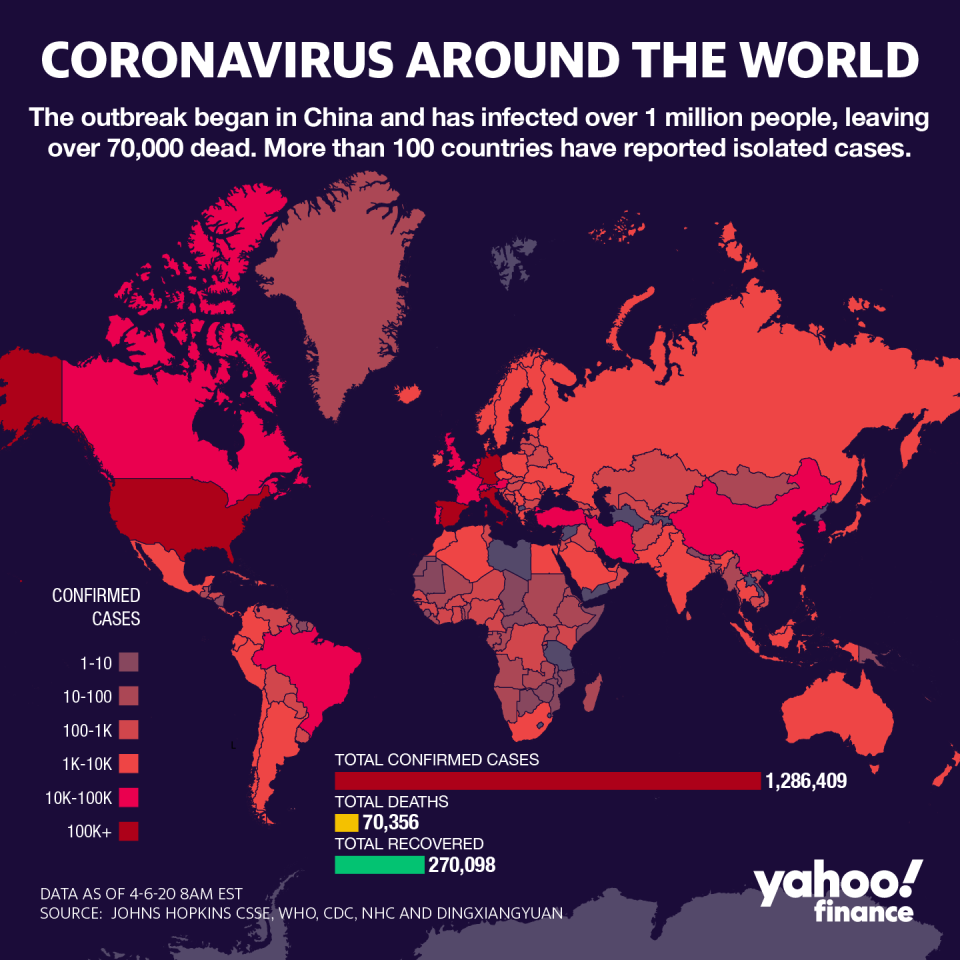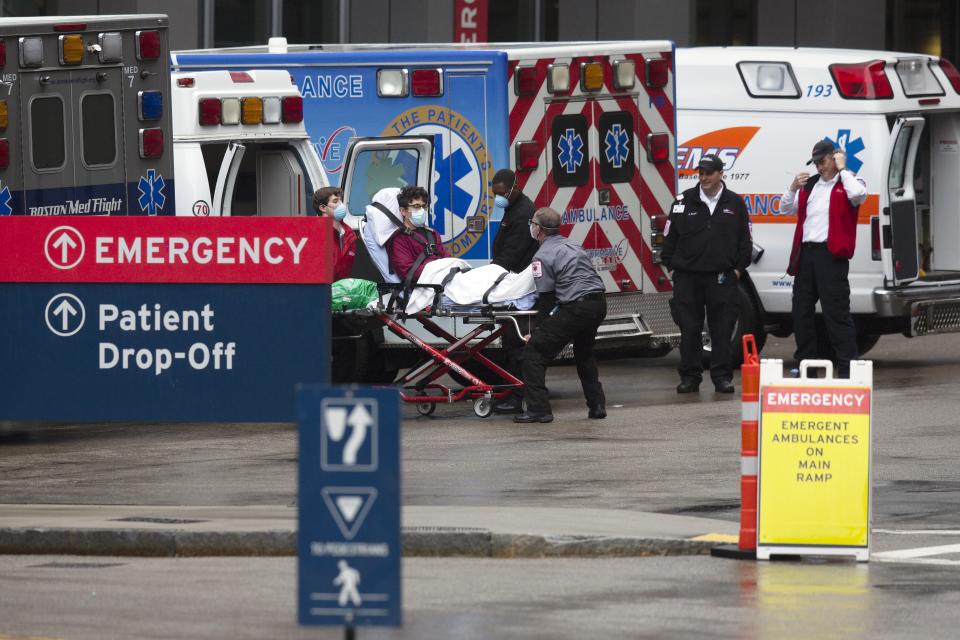Health insurance industry eyes federal aid amid coronavirus pandemic
As American insurers expand coverage for treatment related to the coronavirus, questions are arising about whether insurers will ask for federal aid and whether premiums for Americans will rise in 2021.
President Donald Trump indicated the administration could weigh helping health insurers in the same way hospitals received more than $100 billion in the $2.2 trillion stimulus package he recently signed.
“We haven’t discussed it but we’re talking to them,” Trump said at a daily coronavirus briefing Thursday. “Getting them not to pay copays, in the case of the big ones... that’s a lot of money they gave up. We’re discussing it with the insurance companies.”

Most insurers declined to comment on the potential to ask for government help. Cigna executive Timothy Wentworth recently told Yahoo Finance he doesn’t see the company seeking aid from the federal government.
But America’s Health Insurance Plans, a lobbying group, has already asked the federal government for federal aid in a letter penned to Congress on March 19.
“Establish a temporary, emergency risk mitigation program to ensure that health care premiums do not spike, and that benefits are stable in the future,” the group said in the letter. “Health insurance providers are covering COVID-19 tests and needed treatments.”

‘The federal government could have a payment or reinsurance program’
Cigna (CI), CVS Health (CVS), Humana (HUM), United Health Group (UNH), and Blue Cross Blue Shields have announced increased COVID-19 treatment coverage. Humana, Cigna and BCBS stand out, committing to cover both in-network and out-of-network visits and treatment sought related to the virus. The remainder are covering only in-network.
“The federal government could have a payment or reinsurance program that says the federal government will step up and pay for these costs or a portion of them,” Peter Lee, executive director of Covered California, told Yahoo Finance. “Insurers that could never have priced for a pandemic of this scale [would be] shielded from passing on huge costs to households at America’s businesses.”
Wendell Potter, a former Cigna executive who now advocates for Medicare for All, noted that insurers are saving money by not paying for elective surgeries— which have all but halted in most of the country.
“They will certainly be looking for a handout if they think this gets to be such a pandemic that a large percent of their (enrollees) will need expensive treatment,” Potter told Yahoo Finance.

Will Americans’ premiums rise?
A recent report from Covered California predicting a premium spike as high as 40% for covering treatment has stoked fear that a blanket spike could be coming in 2021.
“There will be a very large bill to pay for caring for the COVID epidemic,” Lee said. “And up til now, rightly, the focus has been on supporting hospitals and looking at the current effects on the economy. But if we don’t turn our attention soon to how these bills will be paid for providing care for millions of Americans, we’re facing another economic tsunami in fall of this year as health care premiums start taking effect for large businesses, small businesses, local and state governments.”
Larry Levitt, executive vice president for health policy at the Kaiser Family Foundation, told Yahoo Finance the situation is still fluid— and that insurers could actually end up benefitting.
“It’s not actually clear they are going to lose money in 2020,” Levitt said.
That’s because the cost of covering copays and deductibles for COVID-19 hospitalizations— which KFF estimates at $13,000 for pneumonia, which has similar treatment plan — might be fairly low compared to the insurer’s burden for hospitalizations.
In addition, insurers aren’t allowed to use previous year’s losses to raise premiums the following year, unless they end up tapping into their reserves, Levitt said.
Insurers are facing increased costs for people who get seriously ill from COVID-19.
But, they're also saving money as elective procedures get postponed.
We have no idea at this point how that's all going to net out this year, and what it might mean for pent up demand next year.— Larry Levitt (@larry_levitt) March 31, 2020
Matthew Rae, also with Kaiser, said the California report is based on very large assumptions, which would have a catastrophic impact on the sector if realized.
“What this highlights is that we have a serious problem on our hands in terms of the number of people who are getting sick and that we have to treat,” Rae said. “It’s their estimate that 60% of the population gets affected — that means about 15 or 20 million people need a hospital admission, that’s what it is.”
Moody’s analysts Dean Ungar and Stefan Kahandaliyanage told Yahoo Finance that if costs stay low, it will be a pretty good year for the industry.
“It’s not going to move the needle all that much” just covering the copays for testing and visits, Kahandaliyanage said, since the amount paid by insurers is usually the larger portion.
In any case, there is an open question about who will ultimately bear the cost of coronavirus-related treatment, or if it is balanced out by savings from reduced utilization of the health system in other areas.
"The main thing that I’ve noticed is this is an epidemic of such scale that no insurance company can hide from it,” Lee said. “No insurance company can avoid the costs. These are costs to Americans. We need to figure out how to address them head on, so we don’t have continued ripple effects in future years that aren’t near ripples, but could be economic tsunamis.”

Employer-sponsored insurance also a factor
Potter stressed that employers are likely “going to be hit with this at a time when many of them are going to be trying to emerge from the financial setback they will be suffering from this epidemic.”
Employers currently have the option of providing the treatment coverage benefits, through the plans managed by major insurers, and the cost is borne by the company.
As a result, employers could see their health care benefit costs jump by as much as 7%, according to an actuarial analysis of self-funded employers by Willis Towers Watson (WLTW).
That 7% is in addition to an already projected 5% increase anticipated for year-over-year.
“Despite employers and employees taking the right precautions at this perilous time, the coronavirus continues to spread and place enormous pressure on our nation’s health care system,” Trevis Parson, chief actuary at Willis Towers Watson, told Yahoo Finance. “This spike in the demand for care is likely to lead to a significant jump in employer health care costs beyond previous expectations. However, the ultimate financial impact will depend on many factors, including the portion of the population infected and the severity of their illness.”

The WLTW analysis determined how much pain employers could feel at various infection levels of the population — noting the costs would be offset by savings from declines in elective procedures, dental, and vision care.
At a 30% infection level, the analysis found total costs could increase between 4% and 7%, depending on how sick COVID-19 patients become. At a 10% infection level, costs could rise between 1% and 3%. And at a 50% infection level — costs could rise from 5% to 7%.
The analysis assumed $250 per person costs for mild cases, $2,500 for moderate, and $30,000 for sever cases of inpatient stays. Catastrophic cases requiring intensive care were estimated at $100,000 per person.
“The effectiveness of our containment strategy will determine what portion of the U.S. population will become infected,” Parson said. “And that will have an impact on additional costs, which employers will need to consider as they design and finalize their benefit strategy and plan for 2021.”
Anjalee and Adriana are reporters for Yahoo Finance. Follow them on Twitter @anjkhem and @adrianambells.
READ MORE:
Coronavirus: White House promises 'cash payment' to hospitals that treat uninsured patients
Coronavirus: Trump administration decides against nationwide special health care enrollment
Coronavirus hospital bills: A look at the costs for Americans
Read the latest financial and business news from Yahoo Finance
Follow Yahoo Finance on Twitter, Facebook, Instagram, Flipboard, SmartNews, LinkedIn,YouTube, and reddit.

 Yahoo Finance
Yahoo Finance 